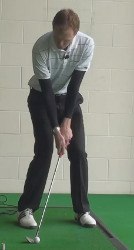
One of the worst places your ball can end up is close to the raised back edge of a bunker. If there's less than a couple of feet between the ball and the lip, your swing is restricted and it's tough to hit the ball with enough force to send it over the front edge and onto the green.
When you find your ball in such a spot, you first need to determine if there's room to take the club up and bring it down behind the ball, with enough speed to cover the length and height required. Worst-case scenario: You can't advance the ball toward the target and must play out sideways or backward.
If you've got room to play toward the green, follow these steps to extract yourself from the situation:
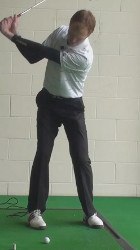
- Take a stance with your right (trailing) foot out of the bunker, if necessary.
- Play the ball well back in your stance, open the clubface slightly and place most of your weight on the left side.
- Your left shoulder should be lower than the right to promote a steeper swing path.
- Pick the club up abruptly, cocking the wrists immediately.
- Swing down sharply, hitting the sand just behind the ball. Make sure you accelerate the club all the way down and through.
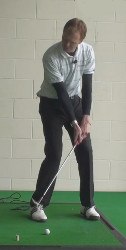
The result may not be pretty, but just getting the ball out of the bunker will feel like a triumph.
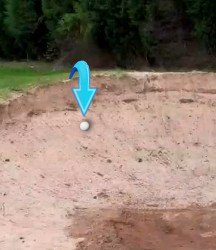
How to Play Ball Against Back Lip of Bunker
It is rarely good news to find your golf ball in a bunker. As soon as you see your ball disappear into a sand trap anywhere on the course, you will know you are in for a challenge. However, that challenge sometimes turns out to not be so bad. If you draw a good lie in the middle of the trap, for example, you should be able to hit the shot up towards the hole without much trouble. On the other hand, if you are unlikely and wind up with a bad lie of some kind, you will consider it a victory if you can simply get out of the sand in a single swing.
In this article, we are going to talk about one specific kind of bad lie in the bunker – the ball resting up against the back lip of the trap. This just might be the worst position of all as far as bunkers are concerned. With the back wall of the bunker in the way of making a clean swing, you will have few options to hit a successful shot. It is possible, of course, to be in the back of any kind of bunker – fairway or greenside – but we are talking specifically about greenside bunkers in this article. While there is nothing we can say that will turn this bad situation into a good one, we hope the advice provided in this article will help you limit the damage and move on.
Before we get into the specifics of strategies and techniques you can use in this spot, we should first talk about your goals when you find yourself in this difficult situation. As soon as you realize that your ball is in a bad spot, you need to adjust your expectations accordingly. This is important, as you can make your situation even worse if you are stubborn and attempt to hit a miraculous shot from an impossible spot.
In most cases, you are going to have to forget about getting up and down for par when the ball is against the back lip. Realistically, you should shift your goal to using three shots to get the ball in the hole, rather than two. Thinking this way is going to help you be more patient when planning your next move. Rather than going for an amazing shot, you can take the safest route into a better position, and then try to get the ball down in two more shots from there. No one likes to give up on a par in favor of a bogey, but you are already in trouble – don't make that trouble worse by being too stubborn to make a rational decision.
All of the content below is based on a right-handed golfer. If you happen to play left-handed, please take a moment to reverse the directions as necessary.
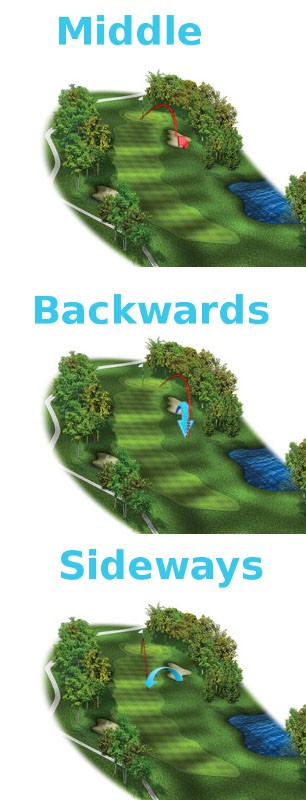
A Couple of Problems
There are two significant problems you are going to have to overcome when your ball is resting in the back of a bunker. First, obviously, is the fact that the side of the bunker will probably be in the way of your swing. If you were to aim at the hole, your backswing would take your club right into the side wall of the trap – and that simply isn't going to work. Depending on how close you are to the side of the bunker, it may be possible to make a partial swing and still send the ball toward the cup. In other cases, you won't have enough room to make any kind of swing at all in the proper direction.
The other problem you are likely to face is the slope of the ground under your feet. If you are in the back of the bunker, it is likely that the ground is sloped down toward the hole. That means it will be hard to elevate your shot properly, if you play in the direction of the hole. So, even if you do manage to create a swing that lets you play toward the hole, you might not be able to hit the shot high enough to get out of the trap. The combination of these two issues is what makes it so difficult to get your ball up and down from this position.
One of the best skills you can develop in this game is the ability to know your limitations. Even if you are confident in your bunker game, there are some challenges that you just can't overcome. This kind of thinking isn't limited to amateur golfers – even the pros need to know when they are up against an impossible shot. The nature of golf is such that the course is going to give you an impossible challenge from time to time. To shoot the best possible scores, you need to understand this and make good decisions that get you out of trouble safely.
Knowing that you might not be able to play your shot up toward the hole, what are your options? The list below highlights three possibilities you can consider when your ball is resting in the back of a greenside bunker.
- Play up into the middle of the bunker. Usually, you wouldn't want to play one bunker shot only to leave yourself with another. However, this is not a usual situation, and you have to do what you have to do. If you can make a small backswing, you might be able to pitch the ball up into the middle of the trap, leaving you with an easy shot for your next swing. As you might imagine, the risk here is playing the ball too far, leaving yourself under the front lip of the bunker and in just as much trouble as you were in for the previous shot. While this is a viable option in some circumstances, you might want to think twice about using this plan in soft bunkers. With soft sand waiting, your first bunker shot may 'plug' into the sand when it lands – making your next shot rather difficult. You will experience the best results with this plan when you are playing a course that has firm sand in the bunkers.
- Play out backwards. Depending on the shape of the bunker, you might be able to turn around and play your shot directly away from the hole. This is only going to work when the back of the bunker is relatively shallow, which is often the case. You won't have much of a follow through with this shot – the back of the bunker will now be in the way of your follow through, rather than your backswing – but that's okay. The sand should slow your club down through impact, meaning you don't need to make much of a follow through anyway. The key with this shot is to actually get the ball out of the trap. If you give up on the shot and leave it in the sand, you'll really be in a tough spot for your next shot – and you will have added a stroke to your scorecard. Take a look at the terrain of the course behind the bunker, and do your best to leave the ball in a good spot to pitch onto the green with your next swing.
- Play out sideways. Our last idea is likely the one that you will use most frequently in this situation. By playing out sideways, you should be able to swing parallel to the back of the bunker, meaning the wall of the trap will no longer be in your way. Just as was the case with the previous idea, you need to make sure to safely get the ball out of the sand with this plan. Find an ideal landing spot off to the side of the trap and do your best to hit that spot with this bunker shot. When executed correctly, this approach will leave your ball in a good position for a chip or pitch shot up toward the hole. Hopefully, you can get down in two from this new position, meaning you'll have gotten down in three shots total from the tough spot you found in the bunker.
In most cases, you are going to have to pick from the three options below when you are in the back of a bunker. You'll need to either play up into the middle of the trap, play out backwards, or play out to the side. None of these will be as fun as playing directly at the hole, and none of them is likely to let you get down in two. With that said, these options are as good as you are going to do from this bad spot, so you can finish out the hole without any more trouble. As long as you are patient and execute your shots, you'll hopefully be able to walk off with a bogey and look forward to better holes ahead.
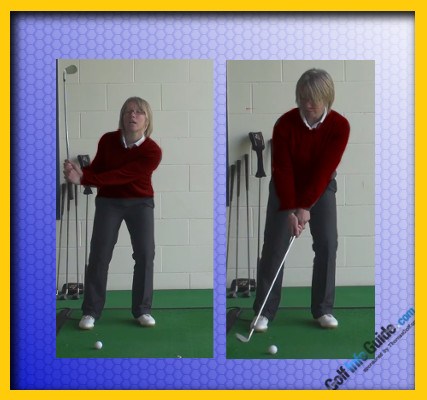
Take a Moment
Golf is a game played by human beings, and human beings get frustrated and angry from time to time. When you hit a shot that leaves you in the back of a bunker, you're likely to feel some of those negative human emotions. That's okay – getting frustrated on the course is simply a sign that you care about your performance. There is nothing wrong with feeling this way, but you can't let your emotions get in the way of your play moving forward.
The best way to have success when you are in the back of a bunker is to take a moment to collect your emotions before getting ready to play the sand shot. You need to calm down after hitting a poor shot with your previous swing, and you also need to get over the frustration of having drawn a bad lie. There is a degree of bad luck involved with winding up in the back of a sand trap, but there is no point in feeling bad for yourself or complaining about your luck. Do your best to think positively and turn your mind away from the frustration and toward finding a solution to your current predicament.
If you walk the golf course during your rounds, you can use the walk up the fairway as time to calm yourself down. Get your mind off of the game for a minute by looking around at the scenery, or chatting with one of your playing partners. Even getting your mind off of golf for just a few moments may be all it takes to allow you to calm down and refocus on the task at hand. For those who ride in a cart during their rounds, it can be a little more difficult to calm down. Your cart can deliver you up to the bunker in just moments, meaning you won't have as much time to let your emotions run their course. Knowing this, consider driving the cart rather slowly up toward the green, or just sit in the cart for a moment before getting out and walking to the bunker.
Learning how to calm down before playing your next shot is a skill that can help you all over the golf course. This is important when you wind up in a bad spot in a bunker, but it is also important when you hit any other kind of poor shot. For instance, you might hit a drive out of bounds, or you may hit an approach shot into the water. It doesn't really matter what kind of shot you hit, the key is to settle down and regain your composure before you move on to the next swing.






